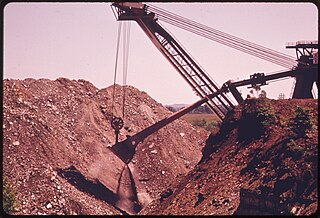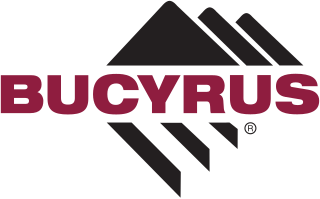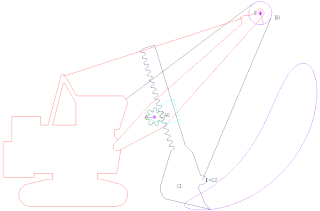Related Research Articles

Excavators are heavy construction equipment primarily consisting of a boom, dipper, bucket and cab on a rotating platform known as the "house" - although the largest form ever, the dragline excavator, eliminated the dipper in favor of a line and winch.

A dragline excavator is a heavy-duty excavator used in civil engineering and surface mining. It was invented in 1904, and presented an immediate challenge to the steam shovel (and its diesel and electric powered descendant, the power shovel. Much more efficient than even the largest of the latter, it enjoyed a heyday in extreme size for most of the 20th century, first becoming challenged by more efficient rotary excavators in the 1950s, then superseded by them on the upper end from the 1970s on.

A steam shovel is a large steam-powered excavating machine designed for lifting and moving material such as rock and soil. It is the earliest type of power shovel or excavator. Steam shovels played a major role in public works in the 19th and early 20th century, being key to the construction of railroads and the Panama Canal. The development of simpler, cheaper diesel, gasoline and electric shovels caused steam shovels to fall out of favor in the 1930s.

Big Brutus is the nickname of the Bucyrus-Erie model 1850-B electric shovel, which was the second largest of its type in operation in the 1960s and 1970s. Big Brutus is the centerpiece of a mining museum in West Mineral, Kansas, United States, where it was used in coal strip mining operations. The shovel was designed to dig from 20 to 69 feet down to unearth relatively shallow coal seams, which would then be mined with smaller equipment.

Bagger 288, previously known as the MAN TAKRAF RB288 built by the German company Krupp for the energy and mining firm Rheinbraun, is a bucket-wheel excavator or mobile strip mining machine.

The Silver Spade was a giant power shovel used for strip mining in southeastern Ohio. Manufactured by Bucyrus-Erie, South Milwaukee, Wisconsin, the model 1950-B was one of two of this model built, the other being its sister ship, the GEM of Egypt. Its sole function was to remove the earth and rock overburden from the coal seam. Attempts to purchase and preserve the shovel from Consol to make it the centerpiece of a mining museum exhibit for $2.6 million fell short. A salvage company began scrapping the machine in January 2009. The boom was dropped using explosives on February 9th, ending any rescue attempts. By March 1st, much of the machine had been cut away.

A bucket-wheel excavator (BWE) is a large heavy equipment machine used in surface mining.

Marion Power Shovel Company was an American firm that designed, manufactured and sold steam shovels, power shovels, blast hole drills, excavators, and dragline excavators for use in the construction and mining industries. The company was a major supplier of steam shovels for the construction of the Panama Canal. The company also built the two crawler-transporters used by NASA for transporting the Saturn V rocket and later the Space Shuttle to their launch pads. The company's shovels played a major role in excavation for Hoover Dam, the Holland Tunnel and the extension of the Number 7 subway line to Main Street in Flushing, Queens.

Big Muskie was a dragline excavator built by Bucyrus-Erie and owned by the Central Ohio Coal Company, weighing 13,500 short tons (12,200 t) and standing nearly 22 stories tall. It mined coal in the U.S. state of Ohio from 1969 to 1991. It was dismantled and sold for scrap in 1999.

A landship is a large land vehicle that travels exclusively on land. Its name is meant to distinguish it from vehicles that travel through other mediums such as conventional ships, airships, and spaceships.

Bucyrus-Erie was an American surface and underground mining equipment company. It was founded as Bucyrus Foundry and Manufacturing Company in Bucyrus, Ohio, in 1880. Bucyrus moved its headquarters to South Milwaukee, Wisconsin, in 1893. In 1927, Bucyrus merged with the Erie Steam Shovel Company to form Bucyrus-Erie. In 1997, it was renamed Bucyrus International, Inc. In 2010 the enterprise was purchased by Caterpillar in a US$7.6 billion transaction that closed on July 8, 2011. At the time of its acquisition, the Bucyrus product line included a range of material removal and material handling products used in both surface and underground mining.

A power shovel, also known as a motor shovel, stripping shovel, front shovel, mining shovel or rope shovel, is a bucket-equipped machine usually powered by steam, diesel fuel, gasoline or electricity and used for digging and loading earth or fragmented rock and for mineral extraction. Power shovels are a type of rope/cable excavator, where the digging arm is controlled and powered by winches and steel ropes, rather than hydraulics like in the modern hydraulic excavators. Basic parts of a power shovel include the track system, cabin, cables, rack, stick, boom foot-pin, saddle block, boom, boom point sheaves and bucket. The size of bucket varies from 0.73 to 53 cubic meters.

The Black Thunder Coal Mine is a surface coal mine in the U.S. state of Wyoming, located in the Powder River Basin which contains one of the largest deposits of coal in the world. In 2022, the mine produced 62,180,000 short tons (56,410,000 t) of coal, over 25% of Wyoming's total coal production.

Ruston-Bucyrus Ltd was an engineering company established in 1930 and jointly owned by Ruston & Hornsby based in Lincoln, England, and Bucyrus-Erie based in South Milwaukee, Wisconsin, the latter of which had operational control and into which the excavator manufacturing operation of Ruston & Hornsby was transferred. The Bucyrus company proper, from which the Bucyrus component of the Ruston-Bucyrus name was created, was an American company founded in 1880, in Bucyrus, Ohio.

Bagger 293, previously known as the MAN TAKRAF RB293, is a giant bucket-wheel excavator made by the German industrial company TAKRAF, formerly an East German Kombinat.

The Ursa Major at Black Thunder Coal Mine, Wyoming, is the largest dragline excavator currently in use in North America and the third largest ever built. It is a Bucyrus-Erie 2570WS model and cost US$50 million. The Ursa Major was one of five large walking draglines operated at Black Thunder, with the next two largest in the dragline fleet being Thor, a B-E 1570W - which has a 97.5-metre (320 ft) boom and a 69-cubic-metre (2,400 cu ft) bucket - and Walking Stick, a B-E 1300W with a 92-metre (302 ft) boom and a 34-cubic-metre (1,200 cu ft) bucket.

P&H Mining Equipment sells drilling and material handling machinery under the "P&H" trademark. The firm is an operating subsidiary of Joy Global Inc. In 2017 Joy Global Inc. was acquired by Komatsu Limited of Tokyo, Japan, and is now known as Komatsu Mining Corporation and operates as a subsidiary of Komatsu.

The Marion Steam Shovel, also known as the Le Roy Steam Shovel, is a historic Model 91 steam shovel manufactured by the Marion Steam Shovel and Dredge Company of Marion, Ohio. It is located on Gulf Road in the Town of Le Roy, New York, United States.

The GEM of Egypt was a power shovel used for strip mining built by Bucyrus-Erie in 1966 for working the Egypt Valley coalfield near Barnesville, Ohio. GEM is an acronym for “Giant Earth Mover” or “Giant Excavating Machine”. It was one of only two Bucyrus-Erie 1950-B shovels built and one of two to use the knee action crowd licensed from Marion Power Shovel in exchange to Marion's use of BE's cable crowd patent.

The term walking excavator may apply to two different forms of heavy equipment, the historic walking power shovel or dragline excavator that began to appear already early in the 20th century, or the contemporary version of all-terrain excavator popularly known as a spider excavator.
References
- 1 2 3 4 5 6 "The Captain's Dying Hours". Coal Age.
- ↑ "Bucyrus page on Marion". Archived from the original on 2008-05-31. Retrieved 2008-09-30.